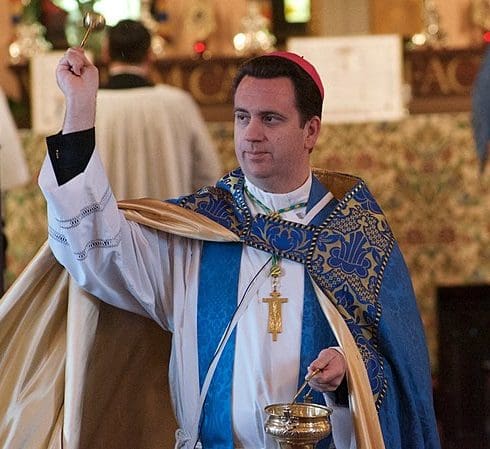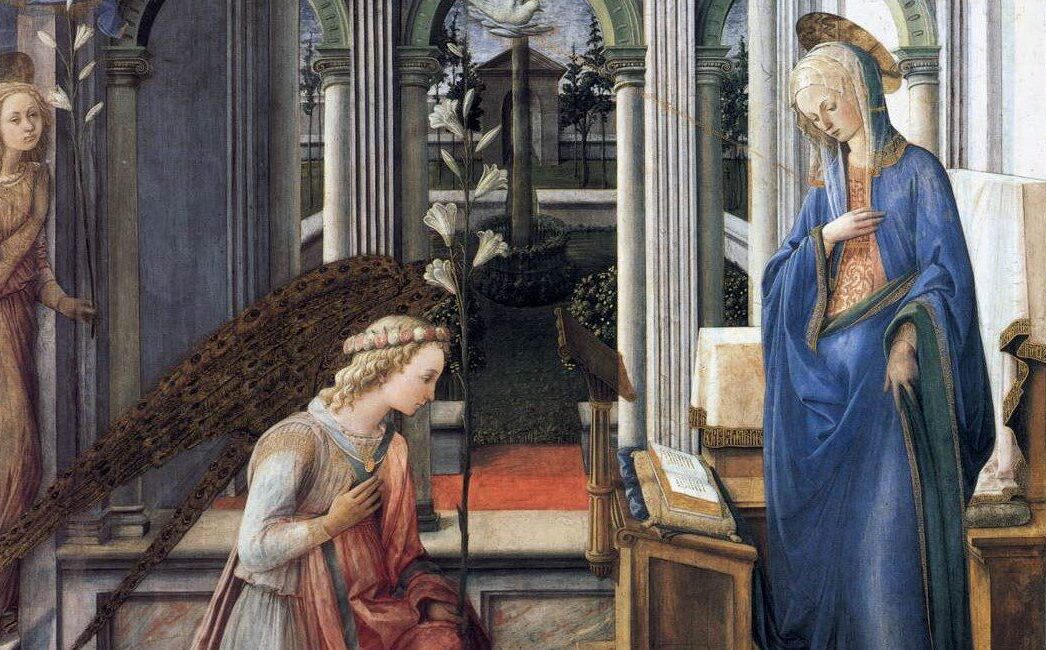Traditionally, the principal sung Mass on Sundays was preceded by the rite of sprinkling with holy water (asperges). The third edition of the Roman Missal evokes this custom when it says, “From time to time on Sundays, especially in Easter time, instead of the customary Penitential Act, the blessing and sprinkling of water may take place as a reminder of Baptism” (General Instruction of the Roman Missal, 51). The texts for this blessing and sprinkling of water are found in Appendix II of the Roman Missal. The customary gestures traditionally associated with this reminder of baptism are still relevant today whenever the sprinkling rite is carried out, even at the Sunday Masses anticipated on Saturday evening.
Invitation to the Blessing
At the beginning of Mass, immediately following the sign of the cross and the greeting of the assembly, the celebrant, standing at the chair with hands joined and still turned toward the assembly, invites all to join him in the prayer of blessing. A server holds the missal in both hands from the sign of the cross to the conclusion of the opening collect. If the celebrant is standing at the chair perpendicular to the altar, the server normally stands directly in front of him during this time. When addressing the assembly, the celebrant turns to face them, with his eyes turning as necessary to read the text of the invitation to prayer. (If the celebrant is directly facing the people, either behind the altar or to one side of the altar, it is perhaps best for the server to stand slightly to his left; in so doing, the server will not block the celebrant from looking at the assembly when he addresses them.)
After inviting the assembly to pray (“Dear brethren, let us humbly beseech the Lord our God to bless this water…), the celebrant turns to face the missal once again as circumstances suggest. During this time, a server has been holding a vessel with water to be blessed. If the missal bearer is standing directly in front of the celebrant, the server holding the vessel with water could stand facing the celebrant, on the celebrant’s left. Another server holding a vessel with salt on a tray could stand to the missal bearer’s left, facing the celebrant on his right. (If the missal bearer is standing slightly to the celebrant’s left because the celebrant’s chair directly faces the assembly, both servers holding the vessels with water and with salt could stand side by side, slightly to the celebrant’s right.)
Blessing of Water
After concluding the invitation the faithful to pray, the celebrant pauses for a brief moment of silence. He then continues with the blessing of the water with hands joined (“Almighty ever-living God, who willed that through water…,” the first option begins). As his left hand rests on his chest, with his right hand he makes the sign of the cross in the shape of a Greek cross over the water at the point indicated in the text. He does the same with the salt if he has decided to use it (the addition of salt to the water is optional). With his right hand he then immediately pours the salt into the water saying nothing (See Roman Missal, Appendix II, no. 3). The book bearer and the minister holding the salt depart.
Sprinkling the Ministers
The deacon or a master of ceremonies dips the sprinkler in the water and presents the sprinkler to the celebrant in his right hand. The celebrant, still standing at the chair, sprinkles himself by touching his forehead with the sprinkler, making the sign of the cross. Alternatively, transferring the sprinkler from his right hand to his left, he touches the thumb of his right hand to the top of the sprinkler and traces the sign of the cross on his forehead before returning the sprinkler to his right hand. While holding the sprinkler in his right hand, his left hand always rests on his chest.
Still standing at the chair, the celebrant can extend the sprinkler first to the deacon, who touches the top of the sprinkler with the closed fingers of his right hand and makes the sign of the cross. The celebrant then can do the same to the server standing in front of him holding the vessel of water in his left hand. It is then perhaps best for the celebrant to proceed to the front of the altar to sprinkle the other ministers in the sanctuary (unless he is already standing at the chair directly behind the altar). Historically, the celebrant began by sprinkling the altar at the center, then left and right, but this is no longer mentioned in either the missal or the Ceremonial for Bishops. Standing at the altar, facing liturgical east, with the deacon to his left (perhaps holding back the folds of his chasuble) and a minister to his right holding the vessel with holy water, the celebrant begins sprinkling those ministers in the sanctuary to his right, then those to his left. The celebrant can sprinkle each group three times, first at their center, then to the left and then to the right.
Sprinkling the People
After sprinkling all those in the sanctuary, the celebrant, the deacon, and the server bow to the altar and turn on their right to sprinkle the people. Upon turning to face the people, the deacon will now be on the celebrant’s right and the minister with the vessel of water will be on his left (See Andre Mutel and Peter Freeman, Ceremonial de la sainte Messe, Editions Artege, 2012, 88). This position makes it easier for the celebrant to dip the sprinkler in the vessel with water as he sprinkles the people.
The celebrant may stand at the entrance to the sanctuary and sprinkle the entire assembly from a stationary position, sprinkling first in the center, then to his left, then to his right, his left hand resting on his chest. More appropriately, the celebrant may move through the church sprinkling as he goes. When processing up the center aisle, he alternately sprinkles those on his right and then his left. (Traditionally, the celebrant sprinkles others as he faces then, not from behind them. This would exclude sprinkling one side of the center aisle as he walks to the back of the church and sprinkling the other side as he returns to the altar.) Having reached the back of the church, the celebrant returns the sprinkler to the vessel of water and joins his hands as he returns to the altar. At this point the deacon and server may switch sides in order to be on the celebrant’s right and his left, respectively, once again.
Concluding Prayer
Upon arriving at the sanctuary, all bow to the altar, and the celebrant and deacon go to their seats. The server places the holy water on the credence table. The server with the missal approaches and stands before the celebrant. The celebrant, facing the people with hands joined (See Appendix II, no. 5) says the concluding prayer (“May almighty God cleanse us of our sins, and through the celebration of this Eucharist make us worthy to share at the table of his Kingdom.”). Then the celebrant (or a master of ceremonies) turns the pages of the missal with his right hand to the Gloria, if required by the rubrics, or to the collect for Mass in the Advent and Lenten seasons. Mass continues in the usual way.
The next post in this series will summarize the traditional manner for handling the incense boat and thurible during Mass, as well as the customary way to carry out the incensations at the various points of Mass in the Novus Ordo.



